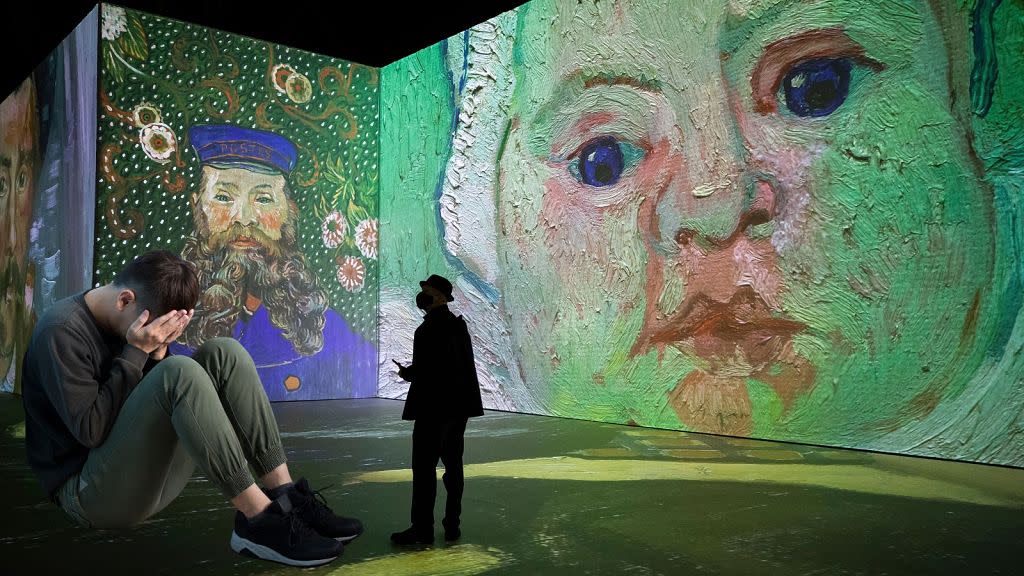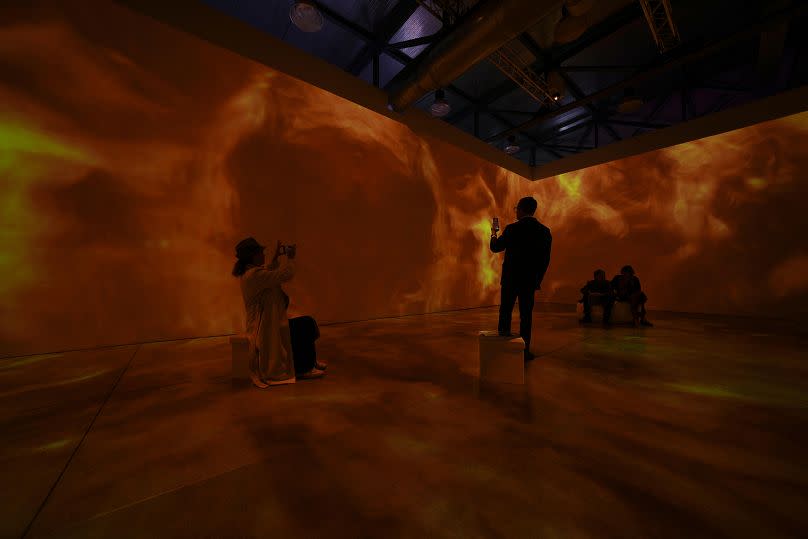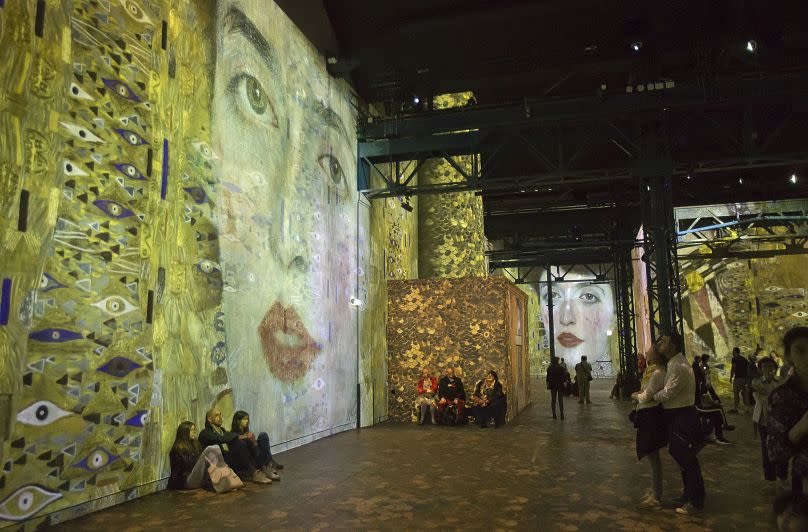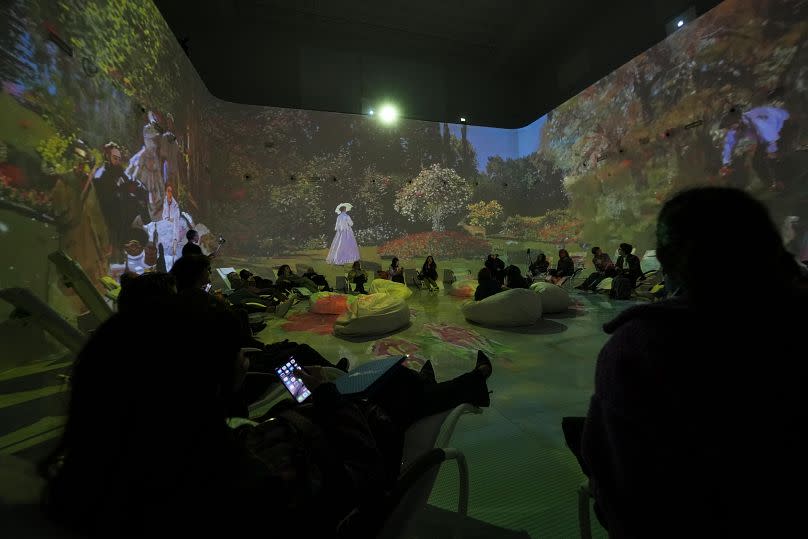Why are we still being scammed by immersive art exhibitions?

I’ve seen Picasso’s "Guernica".
I’ve stood in front of Michelangelo’s David.
I’ve found myself in a trance when faced with Francis Bacon’s “Study after Velázquez's Portrait of Pope Innocent X”.
But I’d never seen anything quite like the immersive Klimt exhibition.
I experienced it during a recent visit to Warsaw. After having sampled the many culinary joys of Poland’s capital (which are numerous and yummy), I ended up at the Klimt event after having been somewhat duped by guides and online reviews to visit the Soho Factory in the old post-industrial area in Praga – Warsaw's east riverside “alternative district”.
Billed as a goldmine of interesting venues and projects, the “current standard-bearer for cool” promised galleries, shops, bars, and “hip hangouts”.
Sadly, nothing of the sort, as the area revealed itself to be some sort of “If you build it, they will come”... but no-one showed up.
After a quick tour of the underwhelming Neon Museum, located in an old industrial space-turned-cultural-space, I was left far from illuminated, and at a loss. Granted, I’ve been spoiled by my time living in Berlin, and so tend to take this into consideration when assessing “hip”. However, if this was part of the vibrant hub of alternative culture, it wasn’t the flex Warsaw thought it was. Or the flex it deserves, for that matter.
I wandered to the Soho Art Center, another space which was described as a must-visit venue for diverse cultural events.
Jackpot. Or so I thought.

My heart sank somewhat when I saw that the current exhibition was an immersive Klimt showcase: "Klimt: The Immersive Exhibition."
I’d been burned before, with the portentous and utterly naff “Van Gogh: The Immersive Experience”, which made me want to forcibly shove fistfuls of sunflowers down my throat to make the experience end quicker. The post-Impressionist's paintings were brought to life via magnified replicas of his art projected onto the walls of the gallery. And the second the “Skull of a Skeleton with Burning Cigarette” appeared to puff on its very own coffin nail, the sheer literalism had me gagging with scorn, and convinced that it would have driven Vincent to chop up more of his body parts in protest.
However, after a quick glance at the online reviews for Klimt, which called it captivating and unmissable, I decided to chance a reappraisal. As my mum is fond of saying: “Il n’y a que les cons qui n’osent pas changer d’avis” (“Only morons don’t dare change their minds”).
Well, this con is keeping his avis sealed, locked in a heavy titanium box and sent down to the Mariana trench on this one. Because for the love of Gustav’s symbolism, gold leaf and eroticism, this was atrocious. Hilariously so.
I shouldn’t have been surprised. From the entrance of the exhibition, I was greeted by a wax figurine of the painter himself, which looked like an anthropomorphized and weathered Peperami that had been placed too close to a radiator. He was haunting, not least because of the material used for his beard, which was indescribably wiry and... well... made me want to enquire about the safety of neighbouring chinchillas.
Then came the fact that the first room featured no actual paintings by Klimt. Only shoddy reproductions adorned the walls, ones that weren’t size accurate and printed on smooth fabrics with a touch of paint for the gold segments.
But even these depressing simulacra didn’t prepare me for the experience I was about to embark on in the second room.
Walking in the vast open space, populated by visitors flopped into underfed beanbags on the floor, peppered about like tragic croutons in this shit salad of an exhibition, I was greeted with lo-res digital projections of Klimt’s paintings being screened from laughably noticeable projectors. The four walls and the floor were cast with the colourful artworks, as well as randomly placed monitors screening the show, having too fallen victim to this projection mapping that purports to simulate an augmented reality.

I tried. I really did.
I sank into a beanbag and let myself be immersed. And honestly, I can comfortably say that I would have been more immersed had I gone to the trouble of purchasing some gold glitter, heading back to my hotel room, laying down on the bed and sporadically chucking aureate sparkles into my face while my eyes glanced over some pictures of Klimt’s paintings on my phone's tony screen. What an imaginarium that would have been.
Back to the confines of the actual exhibition. I could see the original paintings distorting and liquifying into each other, with the occasional rain pour of kitschy pixelated gold shimmers – all soundtracked to a Muzak playlist that completed the son et lumière show.
I wasn’t moved. Or relaxed. Or immersed. I found myself in a sort of out-of-body-experience that only had me wondering: Could I jump from beanbag to beanbag towards the exit while pretending the floor is lava? After all, the ground seemed animated, so it was only natural to embrace that most physically challenging (and mentally enthralling) of childhood games which casts its players as intrepid Indiana Jones stand-ins avoiding the dreaded thought of becoming charred human popsicles.
Still, no price of admission was worth this brief return to childhood – nor the screen that wished me farewell at the end of the exhibit, which had an interactive Klimt painting with a moving mouth that will haunt my nightmares for decades to come. I made my way past the virtual reality headsets and the gift shop counter selling Klimt mugs, laptop covers and keyrings, and left as fast as my legs would take me. Exit through the shit shop, if you will.
Give me Glasgow’s finest Willy Wonka experience over this any day of the week.

Now, I fully realise I must be coming off as an insufferable snob.
After all, this trend of digital art venues is a global phenomenon for a reason, revealing public appetite for new ways of experiencing art. These exhibitions allow audiences to have access to art they wouldn’t have the opportunity to appreciate in person otherwise, and to share a communal experience that should, theoretically, be worth applauding. And why not embrace a new way of seeing and appreciating art, especially if it gives elitist gallery gatekeepers the finger?
However, I came to the realisation that none of this is about sticking it to the man.
The whole Klimt experience may have been initially hilarious, but it dawned on me that these immersive exhibitions are, at best, nothing but a rapidly proliferating and overpriced gimmick and, at worst, a sad reflection on the way we view art nowadays. They are unrepentantly cynical, profit-based excuses to peddle as much merch as possible to those who love the poster artist rather than the artists themselves.
Surely there’s a better way, one which doesn’t buy into this “sensory adventure” nonsense that prioritises slap-dash spectacle over real resonance. Granted, the technology clearly isn’t being invested in to make these exhibitions truly immersive, but if the tech does come to a showroom sometime soon, should we be buying into it?
We really should not. These digital-age swindles only serve to sideline what makes the artworks special in the first place. They syphon emotion and undermine creative decisions to create an approximation of art, existing solely as Instagrammable moments for those looking to “interact” with art for a cheap burst of social media gloating. Because, no word of a lie, I did pass by a pair of teens posing turn by turn in front of a projection as I walked out of the Soho Art Center, clearly loving their posts in which they had golden Klimt segments transposed onto their faces. And good for them. They’re the target audience, and they proved that the business model is working.
I sound like I’m about to break into the Internationale at any given minute, but I assure you that I can completely contain my burning rage about th- screw it.
*Needle drop*
RISE, SISTERS AND BROTHERS.
BREAK YOUR DIGITAL SHACKLES, OVERTHROW THESE CONTEMPTUOUS MARKETING CONCEPTS THAT FURTHER LOWER STANDARDS THROUGH TEMPORARY FIXATIONS.
IMMERSIVE ART ISN’T ART.
DON’T FLOCK TO THE NEXT LO-TECH SHOWING OF VAN GOGH, FRIDA KAHLO OR SALVADOR DALÍ, WHO WOULD ALL BE SPINNING IN THEIR GRAVES LIKE FURIOUS ROTISSERY CHICKENS AT THE MERE THOUGHT OF THIS HERESY, AND TREASURE THEIR ART IN THE WAY IT WAS MEANT TO BE SEEN.
*Needle rise*
Sorry, I went from intellectual snobbery to sacrificing influencers on an altar in a Lenin-theme sabbath...
Mustering what little is left of my sanity, I’ll end with this. Museums faced with the popularity of this demoralizing digital trend need to learn some lessons.
The novelty factor of these experiences may gradually dwindle, but museums and galleries need to do more to combat commercial ventures projecting mutilated versions of dead artists’ works. And if artistic integrity isn’t their primary concern, they should be worried about their attendance and profit numbers. Art shouldn’t belong to the elite. But it certainly deserves better than this scam.
And incidentally, don’t dismiss Warsaw from my experience of the Praga district. The city is charming, and I admit that a plateful of pierogis from the city’s oldest restaurant – the brilliantly named U Fukiera - did make me feel much, much calmer. In a way that no projected culinary immersive experience ever could.
Oh God, I’m giving them ideas...


